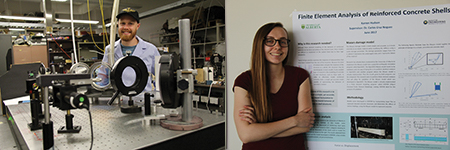
Engineering undergraduates Matthew Rudd and Karen Hudson have spent their summers taking on challenging research projects.
Matthew Rudd: I'm going into my third year of engineering physics, co-op option. I'm working with Dr. Fedosejevs on his research into laser fusion plasma. The end goal of our project is to enable fusion ignition with lasers, and we are currently working towards intermediary steps to achieve this goal, an energy positive fusion where a reaction would generate more energy than it took to fire it. Briefly, we are using high-power lasers to generate extremely powerful magnetic fields - we are talking several orders of magnitude more powerful than the magnetic field of the Earth.
When I originally chose engineering physics as a discipline, I was looking into doing research as a career. I learned about this specific project during laboratory tours with the Engineering Physics Club. Nuclear fusion is something that has interested me, at least on the conceptual level. To me, nuclear fusion is the near-term goal for green energy production.
Research allows me to indulge my curiosity. I have the prerogative to dig deeper if I come across something in the paper that I don't fully understand.
I usually spend about an hour a day working with PhD students in the lab, learning optical techniques - optics is a very precise science that requires hours of alignment and adjustment. I then apply those techniques to small-scale experiments, taking numbers, data, and measurements. I also work in nanoFAB where I fabricate various items for my team, like very thin films of aluminum. It's interesting work, it really brings out the theory I've learned, it supplements my classes very well.
I've developed skills such as laser beam alignment, interferometry, learning how to use a sputtering system, and the specialized tools in the nanoFAB, which is going to be practical for me because I am specializing in nanoengineering. Some other skills I've learned are all-encompassing, such as general research lab safety, as well as laser and chemical safety.
I didn't realize how much ancillary work goes into research. Running experiments and interpreting data constitute a very small fraction of what's actually going on in a research lab. The actual setup and conceptualization of experiments, the acquisition and preparation of the equipment, the sheer amount of administration that's required, are all the tasks that I was unaware of.
I can see how research can allow for a good work-life balance. It is such an independent field - you can really structure your day. I generally work from 7 a.m. to 3 p.m., which is not necessarily something you can get away with in other field of professional engineering.
Karren Hudson: I'm going into my fourth year of structural engineering. I knew Dr. Cruz Noguez from a class he taught me back in the fall, and I asked him about summer jobs. He mentioned research. I started with the Dean's Research Award program in winter, looking into OOFEM, a finite-element modelling software that describes the behaviour of concrete. The model is fairly simple, but it's a challenge to apply it to complex structures such as entire buildings. I was working on providing validation for the model and developing models for some very simple structures.
In early summer, I started modelling a reinforced concrete beam, which was something I had not looked at before. I was running into obstacles every time I tried to add something new to the model. In a few weeks, however, I finally got the model running and was getting good results. The last part of this project will be a document overviewing the beam modelling procedure.
I've also been looking at masonry walls that are made of concrete blocks. Masonry walls haven't been well studies yet and they are difficult to understand because of so many different components with so many different variables. Our project's long-term objective is to improve the equations for calculating the shear strength of masonry walls and identify the parameters with the greatest effect on the shear strength and overall strength of the walls. The research I'm doing is a first step towards the end goal. The project findings could potentially help reinforce masonry walls so that they could endure earthquakes.
Conducting research feels different from being in school-when you're in class, the teacher always knows the answers. In research, however, there were times when I didn't know how to overcome a problem and Dr. Cruz Noguez would not know either. I had to keep trying to think of anything I could change to make the input file work and get the model running.
Throughout this experience, I've mastered problem-solving skills and learned how to come up with new ways to get around a challenge. Finite element modelling is definitely a big one as well. I've also learned a lot about masonry walls-I didn't even know what a masonry wall was before I started the project.
The experience that I've been gaining through my projects is going to be valuable-either in research or industry jobs. The transferrable skills I've acquired apply to any field.